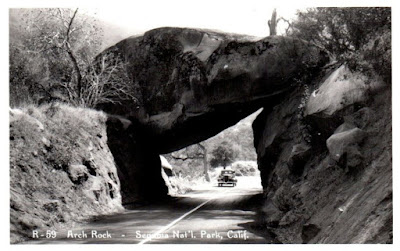Our 2nd Day in the Big Trees...
On September 25, 1890, President Benjamin Harrison signed legislation establishing America's second national park. Created to protect the giant sequoia trees from logging, Sequoia National Park was the first national park formed to protect a living organism: Sequoiadendron giganteum.
Our learning began immediately upon entering the park. History emanates from some objects. Sequoia National Park's entrance sign, with its powerful presence at the boundary, is one such antique. Carved more than 80 years ago, the mammoth 4-foot by 10-foot sign emerged from a slab of sequoia wood from a fallen tree that might have seen two thousand years come and go.The carver, George Muno, served in the Civilian Conservation Corps, a remarkable program that put penniless young men to work here and in other parks during the Great Depression of the 1930s. Muno based the sign on the Native American profile on the old "buffalo" nickel, first minted in 1913. The idea of using such a profile on the park sign came from an earlier, smaller sign that also featured an American Indian man. Both signs were intended to honor Sequoyah, the Cherokee scholar whose invention of an alphabet for his language brought advances in literacy. Many believe that the giant sequoia trees were named for this historic figure.
The growing popularity of automobile travel led to the building of the Generals Highway in 1926, opening up the Giant Forest to increased visitation. Originally, all tourists had to drive through this Tunnel Rock to get to the park (until the road was rerouted). Scary.
The scenery along Generals Highway was spectacular. Driving between the Big Trees was wild.
Big trees, high peaks, and deep canyons in North America’s longest single continuous mountain range: superlatives abound amidst glorious scenery. Pioneering conservationist John Muir explored and named the Giant Forest. “When I entered this sublime wilderness the day was nearly done,” he observed, “the trees with rosy, glowing countenances seemed to be hushed and thoughtful, as if waiting in conscious religious dependence on the sun, and one naturally walked softly and awestricken among them.”
Our first stop today was in the Giant Forest and an ogle of the Sentinel, the 43rd largest giant sequoia in the world (yes, they are ranked).
We then ventured to the Big Trees Trail to marvel at yet more big trees.
"The big tree is Nature's forest masterpiece...
the greatest of living things."
-John Muir
At 7,300', visiting the Monarchs was breathtaking in more ways than one!Our final stop of the day was to see the General Sherman Tree, the world's largest tree, measured by volume. It stands 275 feet tall, and is over 36 feet in diameter at the base. Sequoia trunks remain wide high up. Sixty feet above the base, the Sherman Tree is 17.5 feet in diameter.
The General Sherman Tree is an estimated 2,200 years old. Its largest branch is almost seven feet in diameter. Every year the General Sherman grows enough new wood to make a 60-foot-tall tree of usual proportions.
Are there taller trees? Yes, but size of a tree isn't just measured that way. In volume of total wood the giant sequoia stands alone as the largest living tree on Earth. Its nearly conical trunk—like a club, not a walking stick—shows why. At least one tree species lives longer, one has a greater diameter, three grow taller, but none is larger.
After being awed, we strolled the Congress Trail, a paved two-mile loop that begins near the Sherman Tree, and offered excellent opportunities to see even more notable trees. Wow.And this is another sweet campsite Steve found, nestled in the pines. Boondocking in the forest is best! We are happy campers.






















1 comments:
Love that loop! It is perfect for our little adventurer. She needs to be there. Like in all your pictures with you. She is so cute... :)
Love your camp spot. Is there room for one more?
Post a Comment